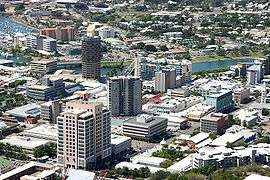Townsville City, Queensland
| Townsville City Townsville, Queensland | |||||||||||||||
|---|---|---|---|---|---|---|---|---|---|---|---|---|---|---|---|
 Townsville City centre | |||||||||||||||
| Population | 2,910 (2016 census)[1] | ||||||||||||||
| Postcode(s) | 4810 | ||||||||||||||
| LGA(s) | City of Townsville | ||||||||||||||
| State electorate(s) | Townsville | ||||||||||||||
| Federal Division(s) | Herbert | ||||||||||||||
| |||||||||||||||
Townsville City (also known colloquially as simply "The City" or "The CBD") is the name of the central suburb of the city of Townsville, Queensland, Australia. It is the city's Central Business District. Townsville CBD is a major hub for businesses of all sectors in the Northern Australia region. In the 2011 census, Townsville City had a population of 2,500 people.[2]
Geography
Townsville City is a strip of land along the northern-eastern bank Ross Creek at its mouth at the Coral Sea, thus the suburb is bounded to the north by the Coral Sea and to the south-east by Ross Creek. It is overlooked to the west by Castle Hill. The land is mostly low-lying, just about sea level, apart from Melton Hill (19°15′21″S 146°49′08″E / 19.2559°S 146.8189°E) which creates a natural boundary to North Ward to the north-west.[3]
History
The Flinders Street public library opened in 1938.[4]
Development
Townsville City is home to many regional offices of various government organisations as well as many private companies, serving as a hub for northern Queensland. There has been extensive construction in the city centre over the last 20 years. These include a major redevelopment on Flinders Street Mall by Jarrod McCracken's construction company and the construction of the North Queensland Cowboys Leagues Club.
Townsville's skyline will change dramatically in as little as 5 years with many projects planned and under construction for the Central Business District (CBD) and Palmer Street. Planning and property experts are now predicting Townsville will have the largest city by size and skyscraper numbers in northern Australia by 2012. The need for office towers in the city outstrips supply, and as a direct result the CBD is being expanded over the Ross River into the old railway yards decommissioned by the Townsville Port. The vision includes 22 skyscrapers which in itself will change the face of Townsville forever. As the population nears the crucial 200,000 mark, Townsville is widely available to many businesses because of its large population and being northern Australia's largest city.
In 2008, the council committed approximately $60 million on upgrading the Flinders Mall and the CBD with renovations concluding in 2011. A major development of the plan is the addition of a 6-storey shopping centre known as Flinders Plaza Shopping Centre which currently is in a state of contention as its primary developers have gone into receivership.
Amenities
CityLibraries Townsville operates a public library in Flinders Street.[5]
Heritage listings
Townsville CBD has a large number of heritage-listed sites.
References
- ↑ Australian Bureau of Statistics (27 June 2017). "Townsville City (State Suburb)". 2016 Census QuickStats. Retrieved 18 April 2018.

- ↑ Australian Bureau of Statistics (31 October 2012). "Townsville City". 2011 Census QuickStats. Retrieved 18 January 2016.

- ↑ "Queensland Globe". State of Queensland. Retrieved 19 January 2016.
- ↑ "Public Libraries Statistical Bulletin 2016-17" (PDF). Public Libraries Connect. State Library of Queensland. November 2017. p. 16. Retrieved 29 January 2018.
- ↑ "Using your libraries: locations and opening hours". Townsville City Council. Retrieved 29 January 2018.
Coordinates: 19°15′29″S 146°49′06″E / 19.2580°S 146.8184°E
